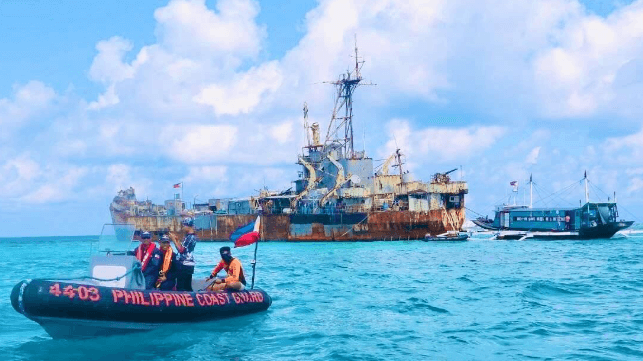Philippines Asks China to Prove "Agreement" to Leave Disputed Reef

This week, the Chinese government claimed that the Philippines promised to remove a small outpost from Second Thomas Shoal, a disputed low-tide feature in the Philippine exclusive economic zone. The Philippine government denied that it had any prior agreement to cede any of its sovereignty in the Spratly Islands, where China's maritime claims overlap with the Philippines' internationally-recognized waters.
The object of China's request is the BRP Sierra Madre, the wrecked World War II LST that serves as a makeshift Philippine base on the reef. China has attempted to blockade the outpost using a fleet of China Coast Guard and Chinese maritime militia assets, which regularly harass Philippine supply convoys with water cannon, laser illumination and aggressive maneuvering.
The Philippine Coast Guard expresses strong condemnation towards the unlawful behavior exhibited by the China Coast Guard vessels (CCG 4203 and CCG 5305) for their unwarranted use of water cannons against the MRRV-4409. Additionally, we call on the CCG to adhere to the COLREGS… pic.twitter.com/iSI2DU6JWP
— Jay Tarriela (@jaytaryela) August 7, 2023
China's foreign ministry has ordered the Philippine government to remove the base and "restore" the reef. In a statement this week, the China Coast Guard even suggested that the Philippine government agreed to remove the wreck back in 1999, the year that the vessel was driven aground.
“I’m not aware of any such arrangement or agreement that the Philippines will remove from its own territory its ship, in this case, the BRP Sierra Madre from the Ayungin Shoal [Second Thomas Shoal],” responded Philippine President Ferdinand Marcos, Jr. on Wednesday. “If there does exist such an agreement, I rescind that agreement now.”
An official in Marcos' National Security Council, Jonathan Malaya, called on China to name the person who made such a promise and prove that it happened. "They are the ones making this claim, therefore it is their responsibility to back up their claim," he told reporters. "Insofar as we’re concerned, we have not and will never sign or agree to anything that would in effect abandon our sovereign rights and jurisdiction over the West Philippine Sea, in particular Ayungin Shoal."
The rhetoric marks a step change in relations between the two nations. Former President Rodrigo Duterte emphasized closer relations with China, and he spoke of accepting China's assertive presence as the price of avoiding war with a superior military. The relationship with Beijing changed quickly under Marcos, who has emphasized ties with the U.S. and has approved new base facilities for American forces on Philippine territory.
The government recently launched a media campaign to show the Chinese blockade at Second Thomas Shoal, and now that the regular convoy run-ins with the China Coast Guard have been widely publicized, there may be less room for accommodating Beijing in the Philippine public square. On Wednesday, a top Philippine Coast Guard official accused China's apologists of treason. "If you are a Filipino, whether in government or private sector, regardless of your politics, defending and making excuses for China's aggressive behavior should deem you unpatriotic, and a traitor," said PCG spokesman Cmdr. Jay Tarriela in a social media post Thursday. "While I recognize freedom of speech as an important right guaranteed by our constitution, it should not be misused as a means to justify unpatriotic actions by acting as China's mouthpiece."
While China asserts that it has a historical and legal basis for ownership of the Spratly Islands and the surrounding waters, the Permanent Court of Arbitration in the Hague rejected its sweeping claims in 2016, including any claim to Second Thomas Shoal. Beijing rejected the court's decision and has ignored it.
“There is no gray area because the arbitral tribunal expressly ruled that Ayungin Shoal [Second Thomas Shoal] is a low-tide feature forming part of the exclusive economic zone of the Philippines,” retired Philippine Supreme Court Associate Justice Antonio Carpio told Rappler. "There is no legal dispute as to the ownership of the oil, fish, and gas. It belongs exclusively to the Philippines."
BRP Sierra Madre may be a fitting symbol of resistance. She was built in six weeks in Evansville, Indiana in 1944, one of the 170-plus LSTs that the Missouri Valley Bridge & Ironyard contributed to the war effort. She served with distinction in the Pacific Theater, and the U.S. Navy reactivated her in 1966 for service in Vietnam, where she supported helicopter gunships and patrol boats in the Mekong Delta. At the end of the war in 1975, she brought 3,000 Vietnamese refugees to Subic Bay, and she was gifted to the Philippines in appreciation for assistance with the evacuation.
